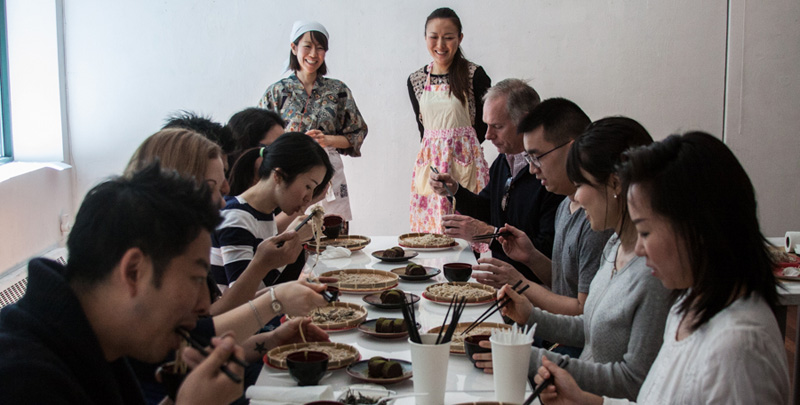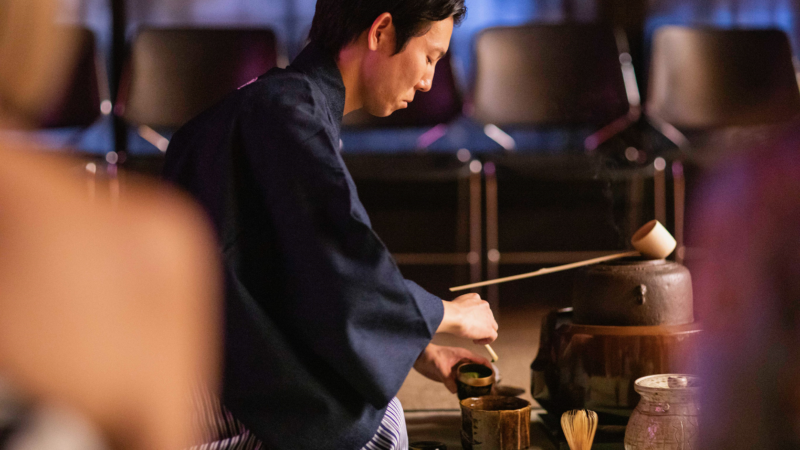Japanese Cooking Blog with Asako Nonaka #3
Asako Nonaka ◆ April 18, 2015

Hi! I’m Asako. Last weekend I finished my part of the Japanese Cooking Workshop at RESOBOX that I had started last year. The last workshop was making handmade soba noodles. We made soba noodles from buckwheat flour by scratch and everyone was very good at cutting their own soba! After that we enjoyed eating the fresh and tasty soba.

Through the seven workshops, I realized again the importance of the relationship between food and the body. I hope all the students who attended these workshops learned the process that we choose seasonal ingredients to cook and eat pleasantly, which will help us have a healthy body and mind.
Thank you to all the students who joined the last workshop. And thank you to Mr. Ikezawa for bringing me such great opportunities. I am going to continue to spread Japanese cooking through the RESOBOX blog, Asakology, my website, and the RESOBOX Japanese Cooking Class Facebook Group so please feel free to check them out.


In my last blog, I introduced 24 Sekki which is old Japanese almanac representing the changing seasons. This time I will explain “穀雨 Kokuu” which literally means “rain for the harvest” and the period is from April 20th to May 4th. Kokuu is the spring rain that leads to the growth of grains and people start to plant rice seeds in rice fields. The sunshine becomes stronger during this period.
At the end of Kokuu, we have “Hachijū hachiya,” literally meaning 88 nights since Risshun. It will be May 2nd in 2015. Hachiju hachiya is one of Zassetsu (雑節) which is a collective term for the seasonal days other than the 24 Sekki. This is the day dividing spring and summer and people start to get ready for summer. In agriculture they start tea-picking. The first tea of this season is called “Shincha” and it has a lot of nutrition and is a good luck drink for eternal youth.

Green tea is both delicious and nutritious, and it’s perfect to drink anytime of the day.
The Nutrition of Green Tea
- Catechin (Polyphenol): Prevents the absorption of fat; contains antioxidants; lowers cholesterol
- L-Theanine (Amino Acids): Umami flavor; has a relaxing effect on the body and mind
- Vitamin C: Antioxidant; reduces stress; helps to keep skin beautiful
- Fluorine: Protects teeth
Now, I am going to introduce a spring recipe using seasonal bamboo shoots.

Recipe: Wakatake-ni
Wakatake-ni is simmered bamboo shoots and seaweed. Bamboo shoots have aspartic acid which helps us recover from fatigue and detoxifies our bodies. Tyrosine helps build better nerves and brain cells and increases concentration.

Ingredients
1 boiled bamboo shoot
2 tbsps of dried wakame (seaweed)
1 cup of dashi
1 tbsp of thin soy sauce
1 tbsp of mirin
1 tsp of brown sugar
bonito flakes
Directions
1. Cut the bamboo shoot into small pieces. Soak the wakame in water.
2. Put dashi, soy sauce, mirin, brown sugar in a pan and turn to a boil. Add the bamboo shoot and simmer for 15 minutes.
3. Drain the wakame and add into the pan and simmer for 2 minutes.
4. Dish them and garnish with bonito flakes.
Feel free to enjoy cooking. If you tried this recipe, feel free to post a comment here. Have a happy spring!




